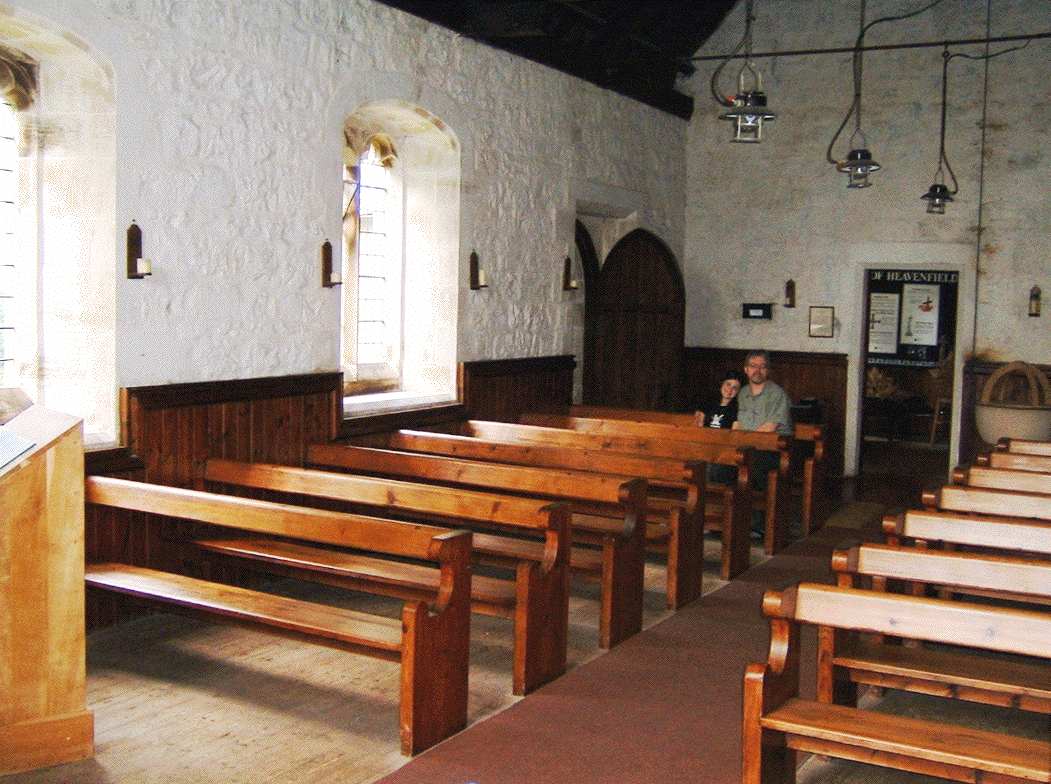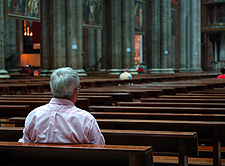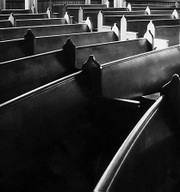 When I look at the pews in the church, and then actually try to sit in a few, all these emotions come into my mind. These things are so small. You have to kind of shuffle sideways in to get into them and I'm not very good at shuffling. I talked to someone from this church recently who said he can't even sit in them because he is too tall and so he sits in the back where there's more room. They also are very uncomfortable and creaky. Wooden seats with a little brown cushion. Once you sit in them and other people sit next to you, you are stuck. It is too tiny to even squeeze past other people to get out should a bathroom emergency arise. Kind of like being in the window seat of an airplane and needing to get out and make your way past two other people in the seats next to you.
When I look at the pews in the church, and then actually try to sit in a few, all these emotions come into my mind. These things are so small. You have to kind of shuffle sideways in to get into them and I'm not very good at shuffling. I talked to someone from this church recently who said he can't even sit in them because he is too tall and so he sits in the back where there's more room. They also are very uncomfortable and creaky. Wooden seats with a little brown cushion. Once you sit in them and other people sit next to you, you are stuck. It is too tiny to even squeeze past other people to get out should a bathroom emergency arise. Kind of like being in the window seat of an airplane and needing to get out and make your way past two other people in the seats next to you.
It's an issue of theology - not comfortability
However - sitting comfortably actually isn't the real issue to me. I know how fortunate we are to have a roof over our head to worship in when many other Christians around the world don't have buildings at all or are persecuted for gathering to worship, so this is all a matter of perspective. So to be honest with you, the "comfortable" factor is actually the least of my concerns. I think my interest and concern over church pews is what they communicate and what they teach theologically about worship and our relationship to one another.
How we sit and arrange a room reflect our values and theology of "church"
 How we meet reflects what we place as important in worship. The original vintage church met in homes, it was communal, looking at each other in small rooms, discussing and teaching Scripture, praying for one another and eating a meal together. You could walk around, have dialog etc. Then the church moved into buildings where the Table (the Lord's Supper) was the focal point and we stood, moved around the room, interacted etc. Then we moved into buildings where the pews caused people to sit in stationary positions, not looking at each other, but looking at the pulpit and all facing the same direction. This drastically changes the culture and climate of how we view when the church gathers to worship. It becomes more of a sit and watch and listen meeting, than an interactive community type of a meeting.
How we meet reflects what we place as important in worship. The original vintage church met in homes, it was communal, looking at each other in small rooms, discussing and teaching Scripture, praying for one another and eating a meal together. You could walk around, have dialog etc. Then the church moved into buildings where the Table (the Lord's Supper) was the focal point and we stood, moved around the room, interacted etc. Then we moved into buildings where the pews caused people to sit in stationary positions, not looking at each other, but looking at the pulpit and all facing the same direction. This drastically changes the culture and climate of how we view when the church gathers to worship. It becomes more of a sit and watch and listen meeting, than an interactive community type of a meeting.
I say all this, because its important understand why we do what we do and why no one questions too often why we do what we do. What we do reflects our theological beliefs and values in many ways - and the pews reflect how we think of what is supposed to happen in worship gatherings. It seems like an odd thing where we meet as a church "family" or we invite someone to experience and be part of a church community, bring them into a room and make them sit for over an hour on these benches crammed in looking at each others back of heads staring at the front of the room. I don't think in our own families, we would have a family meeting and then sit in rows on wooden benches not looking at each other. I am trying to imagine Jesus and His disciples having the last supper meal and sitting in rows of pews as they met. Or as Jesus was teaching them by the Sea of Galilee, did he make them all sit in rows in pews? It seems His teaching was wherever they were, probably in boats, walking, on hillsides, in gardens, at dinner parties, etc. But not one pew is ever mentioned.
"Worship" is not passive or just sitting down looking in one direction
 The common words for worship in the Bible interestingly are "to bow down" or "to kiss towards" which both are actions of the body moving, kneeling, laying down. So the pews actually prohibit that from happening - what worship in the meaning of the word even is.
The common words for worship in the Bible interestingly are "to bow down" or "to kiss towards" which both are actions of the body moving, kneeling, laying down. So the pews actually prohibit that from happening - what worship in the meaning of the word even is.
I guess as I think of pews, I feel restriction, locked in, can't move around, can't kneel down, can't leave to go to prayer areas or pray with someone too easily. I think of looking at backs of heads, not smiling faces. It seems such a far cry from the original church worship gathering and what I believe Jesus had in mind.
Again - this is all said in light of the fact that we should be thankful to have any place to meet or that we are not under persecution, and I agree that this is all pretty small in relationship to the AIDS crisis and famines and many global issues that make me feel silly even being bothered by pews. But they are a real thing, and we shall be sitting in them soon.
How have pews affected your perception of worship? Who are the actors and who is the audience? If you could design worship differently, what would you do? I'd be interested to know.
Email Subscription:


This Sunday, in our Journey Class, we will be in the Upper Room. We’ll explore this concept a bit, especially since it relates directly to our lesson.